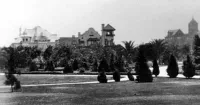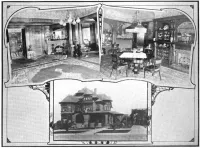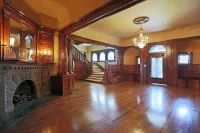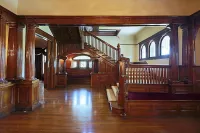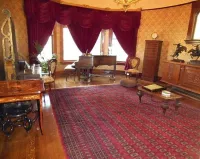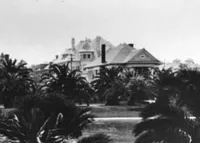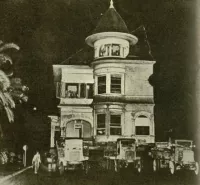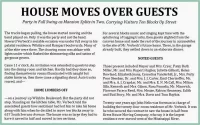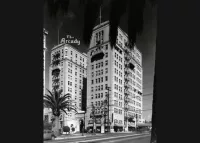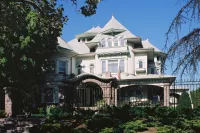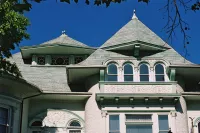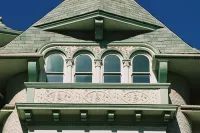Share what you know,
and discover more.
Share what you know,
and discover more.
Jun 01, 2017
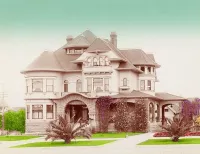
-

- Dave D
2619 Wilshire Boulevard
The 1920s, famously, roared. Counted as megaboom years in dozens of ways that marked the true beginning of modern American life, the social and technological advances of the era lit the fuse of mobility. While Chicago is often remembered as the civic embodiment of the Roaring Twenties in less savory ways, Los Angeles was without question the decade's civic movie star. The city motorized itself into a stupor, sprawling at unprecedented rates, its myriad physical and economic attractions bringing hundreds of thousands of new settlers from points east. With its population more than doubling from 1920 to 1930, there was a mad scramble for housing, and before the boulevards became too crowded for feasible mansion-moving and before the bottom finally dropped out of the roar, there was even a bit of a scramble of houses, among them the Drake and Aronson piles. Generally, the literal moving of houses was away from increasingly crowded downtown neighborhoods to newer tracts to the west. The definition of "West Los Angeles" had begun to shift leftward from West Adams and toward the Pacific years before; with the rise of Beverly Hills, Bel-Air, and Brentwood, among other districts, Windsor Square and Hancock Park were only just becoming mid-town neighborhoods in the '20s, striking the right balance between space and convenience to the still dominant downtown business district. While some houses were moved farther west, it was to these genteel areas that the largest ones—wooden as well as masonry—were most often moved. The most famous of all mobile homes in the city is the Higgins-Verbeck house now, but not always, at 637 South Lucerne Boulevard, just above Wilshire Boulevard in Windsor Square. Attributed to one of the Southland's most in-demand architects and built for Chicago grain merchant Hiram Higgins in 1902, it sat on a flat lot purchased five years before at 2619 Wilshire, at the northeast corner of Rampart between Westlake (MacArthur) and Sunset (Lafayette) parks. In a design review on Valentine's Day of 1904, the Los Angeles Times described the house as: "...one of the really fine pieces of architectural work that are to be found among the more recent additions to the dwellings of this city. It is a 16-room, two-story combination frame and stone structure, with basement and attic. The house was designed by John C. Austin and erected under his supervision...in [a] style...typical of the Romanesque.... The stonework extends up to the windowsills of the first story in some portions of the building and up to the floor line of the second story in other portions. "The first floor includes a reception hall, sitting room, parlor, library, dining room, rear hall, kitchen and pantries. On the second floor are six bedchambers, three bathrooms and three balconies.... The principal rooms of the first floor are finished in oak. The bedrooms of the upper stories are finished in white pine and enamel.... In the attic are three bedrooms, and space for a billiard room. The basement contains storage, fuel and furnace rooms.... The building is lighted by both gas and electricity, and is provided...with modern conveniences.... The house and the improvement of the grounds cost about $37,000." Given little times to enjoy it, Hiram Higgins died in the house on June 1, 1906; an extremely contentious battle over his will ensued, pitting Mrs. Higgins and her son, William, against her daughter Lilian, widow of Charles Wellington Rand. By all accounts a formidable if not unscrupulous woman who was given to referring pretentiously to 2619 as "Whitehall," Mrs. Rand was victorious, wresting her mother's life tenancy in the house away from the old lady. Lilian seems to have made it her business to cultivate the power brokers of the city, including Harrison Gray Otis, who lived down the boulevard at 2401 and who it appears she may have dragooned into her fight with her mother and brother. Otis-Rand family bonds were strengthened with the friendship (and later partnership in the automobile business) of Lilian's son Charles Wellington Rand (apparently born Hiram Higgins Rand but renamed for his father after the latter's death in 1900) and Ralph Chandler, nephew of Harry Chandler, Otis's son-in-law. Ralph Chandler even lived at 2619 for a time. The year 1917 was not a good one for the chatelaine of 2619 Wilshire Boulevard. In February, newspapers reported that Charles Rand was seeking an end to his rocky marriage from a woman he had eloped with in 1911 on the grounds that she had neglected to divorce her previous spouse. (Prior reports had indicated possible cruelty and non-support on the part of Charles.) On July 16, Mrs. Rand managed to survive a serious automobile accident while driving with her friend Mrs. Elmer Clark of 21 Berkeley Square. Harrison Gray Otis died on July 30. And then on October 4, Charles turned up dead as a result of cleaning his gun while preparing to hunt squirrels at his ranch south of Culver City. Dying while cleaning one's gun is practically a euphemism for suicide, but the truth of the incident remains murky. After her annus horribilis, Lilian and her daughter, Lilian Jr., decided to leave Los Angeles for good. It was announced in the Times on October 30, 1917, that after a round-the-world trip, the Rand ladies would settle in either Washington, D.C., or Boston. "Whitehall" would be let for the winter, if not for longer. Two years after the departure of the Rands, an agreement was reached to sell 2619 Wilshire Boulevard to interior decorator Howard Verbeck and the opera singer he had married on March 10, 1919, the former Blanche Avicestell Harriman; four years after that, early on the moonlit morning of June 28, 1923, the house, with great fanfare, migrated westward as a mobile party in honor of soprano Rosa Ponselle was taking place inside. (Miss Ponselle sang long about Vermont Avenue.) It seems that one day Blanche, taken with the house even before she married Howard, noticed the advertisement of master house mover George R. Kress, one depicting a globe being held by ice tongs along with the slogan, "If we had room to work, we could move the world." Consulting John Austin's original blueprints and taking four months, workmen used among other tools fine keyhole saws to carve the house into pieces that would fit down the as-yet-unwidened Wilshire Boulevard; carpenters included a man with personal knowledge, having been among the original team of builders in 1902. The Department of Buildings issued permits to relocate the house and its garage on April 20 as the Kress team continued its preparations and to ready its enormous trucks. One charming anecdote about the move has to do with 17-year-old Jackson Correll Baker, who, from the window of his family's apartment at the Hershey Arms across Wilshire Boulevard from 2619, had observed the preparation of the house and its departure. Some years later, Mr. Baker, having become an electrical engineer in the film business, met and married Marjorie Harriman of the U.C.L.A. art-department faculty. She was Blanche Verbeck's daughter from her previous marriage and had spent her teenage years and young adulthood in the same house on two different Los Angeles streets. Apparently it was once cheaper to move a building the size of the Verbeck house—and even larger, multistory office buildings—rather than erect something new on a lot, but it must have cost a small fortune to install a new foundation and put the pieces back together. In the case of the Higgins-Verbeck house, some savings might have been realized in terms of cosmetics (plaster repair, painting, modernizing, etc.), given Howard Verbeck's profession. If only such moves had remained economically viable operations.... While it would be preferable for the neighborhoods they were built in to return to glory, hundreds of magnificent Los Angeles houses could still be rescued and we'd be spared the indignities of much new domestic architectural horror. Illustrations: USCDL; Los Angeles Past; LAT; EstateSalesNET; Just Above Sunset; LAPL; Building Age and Builder's Journal; Zillow; Men of Achievement in the Great Southwest; GSV
2619 Wilshire Boulevard
The 1920s, famously, roared. Counted as megaboom years in dozens of ways that marked the true beginning of modern American life, the social and technological advances of the era lit the fuse of mobility. While Chicago is often remembered as the civic embodiment of the Roaring Twenties in less savory ways, Los Angeles was without question the decade's civic movie star. The city motorized itself into a stupor, sprawling at unprecedented rates, its myriad physical and economic attractions bringing hundreds of thousands of new settlers from points east. With its population more than doubling from 1920 to 1930, there was a mad scramble for housing, and before the boulevards became too crowded for feasible mansion-moving and before the bottom finally dropped out of the roar, there was even a bit of a scramble of houses, among them the Drake and Aronson piles. Generally, the literal moving of houses was away from increasingly crowded downtown neighborhoods to newer tracts to the west. The definition of "West Los Angeles" had begun to shift leftward from West Adams and toward the Pacific years before; with the rise of Beverly Hills, Bel-Air, and Brentwood, among other districts, Windsor Square and Hancock Park were only just becoming mid-town neighborhoods in the '20s, striking the right balance between space and convenience to the still dominant downtown business district. While some houses were moved farther west, it was to these genteel areas that the largest ones—wooden as well as masonry—were most often moved. The most famous of all mobile homes in the city is the Higgins-Verbeck house now, but not always, at 637 South Lucerne Boulevard, just above Wilshire Boulevard in Windsor Square. Attributed to one of the Southland's most in-demand architects and built for Chicago grain merchant Hiram Higgins in 1902, it sat on a flat lot purchased five years before at 2619 Wilshire, at the northeast corner of Rampart between Westlake (MacArthur) and Sunset (Lafayette) parks. In a design review on Valentine's Day of 1904, the Los Angeles Times described the house as: "...one of the really fine pieces of architectural work that are to be found among the more recent additions to the dwellings of this city. It is a 16-room, two-story combination frame and stone structure, with basement and attic. The house was designed by John C. Austin and erected under his supervision...in [a] style...typical of the Romanesque.... The stonework extends up to the windowsills of the first story in some portions of the building and up to the floor line of the second story in other portions. "The first floor includes a reception hall, sitting room, parlor, library, dining room, rear hall, kitchen and pantries. On the second floor are six bedchambers, three bathrooms and three balconies.... The principal rooms of the first floor are finished in oak. The bedrooms of the upper stories are finished in white pine and enamel.... In the attic are three bedrooms, and space for a billiard room. The basement contains storage, fuel and furnace rooms.... The building is lighted by both gas and electricity, and is provided...with modern conveniences.... The house and the improvement of the grounds cost about $37,000." Given little times to enjoy it, Hiram Higgins died in the house on June 1, 1906; an extremely contentious battle over his will ensued, pitting Mrs. Higgins and her son, William, against her daughter Lilian, widow of Charles Wellington Rand. By all accounts a formidable if not unscrupulous woman who was given to referring pretentiously to 2619 as "Whitehall," Mrs. Rand was victorious, wresting her mother's life tenancy in the house away from the old lady. Lilian seems to have made it her business to cultivate the power brokers of the city, including Harrison Gray Otis, who lived down the boulevard at 2401 and who it appears she may have dragooned into her fight with her mother and brother. Otis-Rand family bonds were strengthened with the friendship (and later partnership in the automobile business) of Lilian's son Charles Wellington Rand (apparently born Hiram Higgins Rand but renamed for his father after the latter's death in 1900) and Ralph Chandler, nephew of Harry Chandler, Otis's son-in-law. Ralph Chandler even lived at 2619 for a time. The year 1917 was not a good one for the chatelaine of 2619 Wilshire Boulevard. In February, newspapers reported that Charles Rand was seeking an end to his rocky marriage from a woman he had eloped with in 1911 on the grounds that she had neglected to divorce her previous spouse. (Prior reports had indicated possible cruelty and non-support on the part of Charles.) On July 16, Mrs. Rand managed to survive a serious automobile accident while driving with her friend Mrs. Elmer Clark of 21 Berkeley Square. Harrison Gray Otis died on July 30. And then on October 4, Charles turned up dead as a result of cleaning his gun while preparing to hunt squirrels at his ranch south of Culver City. Dying while cleaning one's gun is practically a euphemism for suicide, but the truth of the incident remains murky. After her annus horribilis, Lilian and her daughter, Lilian Jr., decided to leave Los Angeles for good. It was announced in the Times on October 30, 1917, that after a round-the-world trip, the Rand ladies would settle in either Washington, D.C., or Boston. "Whitehall" would be let for the winter, if not for longer. Two years after the departure of the Rands, an agreement was reached to sell 2619 Wilshire Boulevard to interior decorator Howard Verbeck and the opera singer he had married on March 10, 1919, the former Blanche Avicestell Harriman; four years after that, early on the moonlit morning of June 28, 1923, the house, with great fanfare, migrated westward as a mobile party in honor of soprano Rosa Ponselle was taking place inside. (Miss Ponselle sang long about Vermont Avenue.) It seems that one day Blanche, taken with the house even before she married Howard, noticed the advertisement of master house mover George R. Kress, one depicting a globe being held by ice tongs along with the slogan, "If we had room to work, we could move the world." Consulting John Austin's original blueprints and taking four months, workmen used among other tools fine keyhole saws to carve the house into pieces that would fit down the as-yet-unwidened Wilshire Boulevard; carpenters included a man with personal knowledge, having been among the original team of builders in 1902. The Department of Buildings issued permits to relocate the house and its garage on April 20 as the Kress team continued its preparations and to ready its enormous trucks. One charming anecdote about the move has to do with 17-year-old Jackson Correll Baker, who, from the window of his family's apartment at the Hershey Arms across Wilshire Boulevard from 2619, had observed the preparation of the house and its departure. Some years later, Mr. Baker, having become an electrical engineer in the film business, met and married Marjorie Harriman of the U.C.L.A. art-department faculty. She was Blanche Verbeck's daughter from her previous marriage and had spent her teenage years and young adulthood in the same house on two different Los Angeles streets. Apparently it was once cheaper to move a building the size of the Verbeck house—and even larger, multistory office buildings—rather than erect something new on a lot, but it must have cost a small fortune to install a new foundation and put the pieces back together. In the case of the Higgins-Verbeck house, some savings might have been realized in terms of cosmetics (plaster repair, painting, modernizing, etc.), given Howard Verbeck's profession. If only such moves had remained economically viable operations.... While it would be preferable for the neighborhoods they were built in to return to glory, hundreds of magnificent Los Angeles houses could still be rescued and we'd be spared the indignities of much new domestic architectural horror. Illustrations: USCDL; Los Angeles Past; LAT; EstateSalesNET; Just Above Sunset; LAPL; Building Age and Builder's Journal; Zillow; Men of Achievement in the Great Southwest; GSV
Jun 01, 2017
2619 Wilshire Boulevard
The 1920s, famously, roared. Counted as megaboom years in dozens of ways that marked the true beginning of modern American life, the social and technological advances of the era lit the fuse of mobility. While Chicago is often remembered as the civic embodiment of the Roaring Twenties in less savory ways, Los Angeles was without question the decade's civic movie star. The city motorized itself into a stupor, sprawling at unprecedented rates, its myriad physical and economic attractions bringing hundreds of thousands of new settlers from points east. With its population more than doubling from 1920 to 1930, there was a mad scramble for housing, and before the boulevards became too crowded for feasible mansion-moving and before the bottom finally dropped out of the roar, there was even a bit of a scramble of houses, among them the Drake and Aronson piles. Generally, the literal moving of houses was away from increasingly crowded downtown neighborhoods to newer tracts to the west. The definition of "West Los Angeles" had begun to shift leftward from West Adams and toward the Pacific years before; with the rise of Beverly Hills, Bel-Air, and Brentwood, among other districts, Windsor Square and Hancock Park were only just becoming mid-town neighborhoods in the '20s, striking the right balance between space and convenience to the still dominant downtown business district. While some houses were moved farther west, it was to these genteel areas that the largest ones—wooden as well as masonry—were most often moved.The most famous of all mobile homes in the city is the Higgins-Verbeck house now, but not always, at 637 South Lucerne Boulevard, just above Wilshire Boulevard in Windsor Square. Attributed to one of the Southland's most in-demand architects and built for Chicago grain merchant Hiram Higgins in 1902, it sat on a flat lot purchased five years before at 2619 Wilshire, at the northeast corner of Rampart between Westlake (MacArthur) and Sunset (Lafayette) parks. In a design review on Valentine's Day of 1904, the Los Angeles Times described the house as:
"...one of the really fine pieces of architectural work that are to be found among the more recent additions to the dwellings of this city. It is a 16-room, two-story combination frame and stone structure, with basement and attic. The house was designed by John C. Austin and erected under his supervision...in [a] style...typical of the Romanesque.... The stonework extends up to the windowsills of the first story in some portions of the building and up to the floor line of the second story in other portions.
"The first floor includes a reception hall, sitting room, parlor, library, dining room, rear hall, kitchen and pantries. On the second floor are six bedchambers, three bathrooms and three balconies.... The principal rooms of the first floor are finished in oak. The bedrooms of the upper stories are finished in white pine and enamel.... In the attic are three bedrooms, and space for a billiard room. The basement contains storage, fuel and furnace rooms.... The building is lighted by both gas and electricity, and is provided...with modern conveniences.... The house and the improvement of the grounds cost about $37,000."
Given little times to enjoy it, Hiram Higgins died in the house on June 1, 1906; an extremely contentious battle over his will ensued, pitting Mrs. Higgins and her son, William, against her daughter Lilian, widow of Charles Wellington Rand. By all accounts a formidable if not unscrupulous woman who was given to referring pretentiously to 2619 as "Whitehall," Mrs. Rand was victorious, wresting her mother's life tenancy in the house away from the old lady. Lilian seems to have made it her business to cultivate the power brokers of the city, including Harrison Gray Otis, who lived down the boulevard at 2401 and who it appears she may have dragooned into her fight with her mother and brother. Otis-Rand family bonds were strengthened with the friendship (and later partnership in the automobile business) of Lilian's son Charles Wellington Rand (apparently born Hiram Higgins Rand but renamed for his father after the latter's death in 1900) and Ralph Chandler, nephew of Harry Chandler, Otis's son-in-law. Ralph Chandler even lived at 2619 for a time.
The year 1917 was not a good one for the chatelaine of 2619 Wilshire Boulevard. In February, newspapers reported that Charles Rand was seeking an end to his rocky marriage from a woman he had eloped with in 1911 on the grounds that she had neglected to divorce her previous spouse. (Prior reports had indicated possible cruelty and non-support on the part of Charles.) On July 16, Mrs. Rand managed to survive a serious automobile accident while driving with her friend Mrs. Elmer Clark of 21 Berkeley Square. Harrison Gray Otis died on July 30. And then on October 4, Charles turned up dead as a result of cleaning his gun while preparing to hunt squirrels at his ranch south of Culver City. Dying while cleaning one's gun is practically a euphemism for suicide, but the truth of the incident remains murky. After her annus horribilis, Lilian and her daughter, Lilian Jr., decided to leave Los Angeles for good. It was announced in the Times on October 30, 1917, that after a round-the-world trip, the Rand ladies would settle in either Washington, D.C., or Boston. "Whitehall" would be let for the winter, if not for longer.
Two years after the departure of the Rands, an agreement was reached to sell 2619 Wilshire Boulevard to interior decorator Howard Verbeck and the opera singer he had married on March 10, 1919, the former Blanche Avicestell Harriman; four years after that, early on the moonlit morning of June 28, 1923, the house, with great fanfare, migrated westward as a mobile party in honor of soprano Rosa Ponselle was taking place inside. (Miss Ponselle sang long about Vermont Avenue.) It seems that one day Blanche, taken with the house even before she married Howard, noticed the advertisement of master house mover George R. Kress, one depicting a globe being held by ice tongs along with the slogan, "If we had room to work, we could move the world." Consulting John Austin's original blueprints and taking four months, workmen used among other tools fine keyhole saws to carve the house into pieces that would fit down the as-yet-unwidened Wilshire Boulevard; carpenters included a man with personal knowledge, having been among the original team of builders in 1902. The Department of Buildings issued permits to relocate the house and its garage on April 20 as the Kress team continued its preparations and to ready its enormous trucks. One charming anecdote about the move has to do with 17-year-old Jackson Correll Baker, who, from the window of his family's apartment at the Hershey Arms across Wilshire Boulevard from 2619, had observed the preparation of the house and its departure. Some years later, Mr. Baker, having become an electrical engineer in the film business, met and married Marjorie Harriman of the U.C.L.A. art-department faculty. She was Blanche Verbeck's daughter from her previous marriage and had spent her teenage years and young adulthood in the same house on two different Los Angeles streets.
Apparently it was once cheaper to move a building the size of the Verbeck house—and even larger, multistory office buildings—rather than erect something new on a lot, but it must have cost a small fortune to install a new foundation and put the pieces back together. In the case of the Higgins-Verbeck house, some savings might have been realized in terms of cosmetics (plaster repair, painting, modernizing, etc.), given Howard Verbeck's profession. If only such moves had remained economically viable operations.... While it would be preferable for the neighborhoods they were built in to return to glory, hundreds of magnificent Los Angeles houses could still be rescued and we'd be spared the indignities of much new domestic architectural horror.
Illustrations: USCDL; Los Angeles Past; LAT; EstateSalesNET;
Just Above Sunset; LAPL; Building Age and Builder's Journal;
Zillow; Men of Achievement in the Great Southwest; GSV
Posted Date
Mar 03, 2022
Historical Record Date
Jun 01, 2017
Source Name
Wilshire Boulevard Houses
Delete Story
Are you sure you want to delete this story?
Jun 01, 2005
Jun 01, 2005
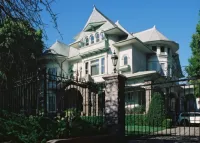
-

- Dave D
Higgins/Verbeck/Hirsch Mansion
Hiram Higgins was a Chicago grain merchant who decided to make his home in Los Angeles on the city's newest grand boulevard. His nine-bedroom, Queen Anne-style mansion was originally built further east on Wilshire at Rampart Street, where the Wilshire Royale apartments now stand. In 1924, the home's new owner had the house cut into three sections, lifted onto trucks, and rolled to its current location in Windsor Square. The owner held a party in one of the moving sections, attended by the mayor of Los Angeles. After the Great Depression, the home fell into disrepair over a half-century of neglect. During this time, it was used as a retirement home for nuns, a mission, an office, and a rooming house for young aspiring actors. In 1986, Perry and Peggy Hirsch rescued the historic mansion. They spent years renovating and restoring it to its former glory. In 1988, the estate was designated as a Los Angeles Cultural-Historic Monument. In addition to reigning prominently over Windsor Square, the mansion has also starred on the silver screen, appearing in numerous films and television series over the years. Some titles include Willard, Ben, and “Beverly Hills 90210.” Now retired from the entertainment business, the timeless Higgins/Verbeck/Hirsch Mansion and its incredible story live on. Photos by Larry Underhill, 2005
Higgins/Verbeck/Hirsch Mansion
Hiram Higgins was a Chicago grain merchant who decided to make his home in Los Angeles on the city's newest grand boulevard. His nine-bedroom, Queen Anne-style mansion was originally built further east on Wilshire at Rampart Street, where the Wilshire Royale apartments now stand. In 1924, the home's new owner had the house cut into three sections, lifted onto trucks, and rolled to its current location in Windsor Square. The owner held a party in one of the moving sections, attended by the mayor of Los Angeles. After the Great Depression, the home fell into disrepair over a half-century of neglect. During this time, it was used as a retirement home for nuns, a mission, an office, and a rooming house for young aspiring actors. In 1986, Perry and Peggy Hirsch rescued the historic mansion. They spent years renovating and restoring it to its former glory. In 1988, the estate was designated as a Los Angeles Cultural-Historic Monument. In addition to reigning prominently over Windsor Square, the mansion has also starred on the silver screen, appearing in numerous films and television series over the years. Some titles include Willard, Ben, and “Beverly Hills 90210.” Now retired from the entertainment business, the timeless Higgins/Verbeck/Hirsch Mansion and its incredible story live on. Photos by Larry Underhill, 2005
Higgins/Verbeck/Hirsch Mansion
Hiram Higgins was a Chicago grain merchant who decided to make his home in Los Angeles on the city's newest grand boulevard. His nine-bedroom, Queen Anne-style mansion was originally built further east on Wilshire at Rampart Street, where the Wilshire Royale apartments now stand.In 1924, the home's new owner had the house cut into three sections, lifted onto trucks, and rolled to its current location in Windsor Square. The owner held a party in one of the moving sections, attended by the mayor of Los Angeles.
After the Great Depression, the home fell into disrepair over a half-century of neglect. During this time, it was used as a retirement home for nuns, a mission, an office, and a rooming house for young aspiring actors.
In 1986, Perry and Peggy Hirsch rescued the historic mansion. They spent years renovating and restoring it to its former glory. In 1988, the estate was designated as a Los Angeles Cultural-Historic Monument.
In addition to reigning prominently over Windsor Square, the mansion has also starred on the silver screen, appearing in numerous films and television series over the years. Some titles include Willard, Ben, and “Beverly Hills 90210.”
Now retired from the entertainment business, the timeless Higgins/Verbeck/Hirsch Mansion and its incredible story live on.
Photos by Larry Underhill, 2005
Posted Date
Feb 14, 2022
Historical Record Date
Jun 01, 2005
Source Name
Los Angeles Conservancy
Delete Story
Are you sure you want to delete this story?


